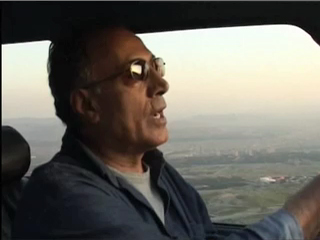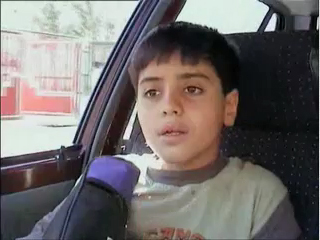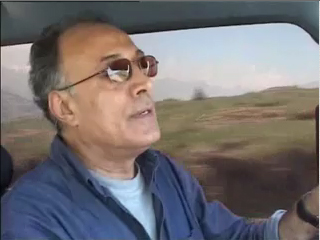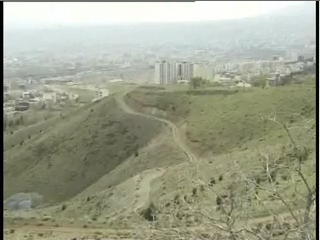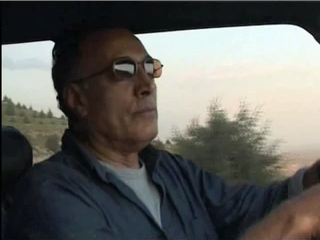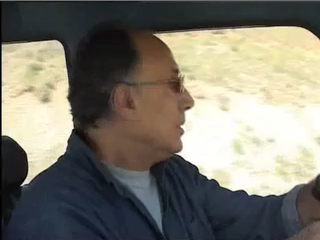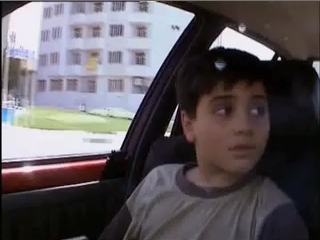Digital Kiarostami & The Open Screenplay
Alex Munt
You can make a good film which is just that, a good film. But sometimes there are films which are not so good, but they are still worthwhile because they suggest new directions. Abbas Kiarostami (Levieux 2002 quoted in Elena 2005: 175)
Ten (2002) by Abbas Kiarostami is a challenging film, in the best sense of the word. It is a claustrophobic, tense, and at times, frustrating experience. Yet it is also an entirely cinematic film. Ten is Kiarostami’s twelfth feature, and of particular interest here, his first digital fiction feature. The film represents a radical departure from his preceding films which have been reserved as “full fledged masterpieces” (Sterritt, 2000). This is difficult to claim of Ten. Rather, as Kiarostami attests, the value of this film lies elsewhere: as a ‘new direction’ for cinema.
This article posits that this new direction is towards a ‘Digital-Micro-Cinema’ – defined here as micro-budget filmmaking practice allied with a digital production basis. The fact that Kiarostami opted to shoot a feature digitally and on a micro-budget, suggests that this new, or modified, brand of cinema has afforded the opportunity (for an established world cinema director) to explore new ways in which to narrate stories (Ganz and Khatib 2006: 28). This article looks at ‘new ways’ of (cinematic) scriptwriting, in a digital context, and the transformation of narrative in this arena. The focus of the article is on Kiarostami’s notion of the ‘Open Screenplay’ with emphasis on its digital re-embodiment in Ten.
Digital-Micro-Cinema
But what in fact is Ten? Structurally speaking, Ten is no more than a collection of ten sequences – hence the title, obviously – in which a woman has different conversations with her various passengers as she drives through the streets of Tehran (Elena 2005: 175).
Kiarostami has long practised a ‘micro’ (or minimal) mode of cinema, in resistance to the Hollywood model and its imitators. A series of trademarks are evident from his films and are reflective of a small-scale approach to feature filmmaking. These include: use of non-professional actors, experiments with fiction/documentary hybrids, a favour for the ‘sequence shot’ and play with temps-mort (dead time). Kiarostami’s cinema is generated from an idiosyncratic approach to scriptwriting; in a form he refers to as the “Open Screenplay” (Kiarostami 2004).
This discussion actually revolves around two Kiarostami films. The first being Ten, the other 10 on Ten (Kiarostami 2004), which screened in Un certain regard at Cannes Festival (2004) and now accompanies Ten as a DVD extra (Madman Director’s Suite). 10 on Ten inverts the structure of Ten and unfolds as a series of ‘lessons’ (a Kiarostami master class of sorts) which count from [#1] to [#10]. Although 10 on Ten represents, to a degree, a reformulation of ideas enunciated in previous interviews, it affords intimate access to Kiarostami’s reflections on his recent transition to digital cinema (Elena 2005: 180). The film functions as a (loosely structured) manifesto for the digital debate. In 10 on Ten, Kiarostami speaks from behind the wheel of his Range Rover as it winds around roads adjacent to the principle shooting locations from Taste of Cherry (Kiarostami 1997). The location here is significant, in that Taste of Cherry represents Kiarostami’s first incursion into digital cinema. Kiarostami frames this trajectory as an accident. After a film lab error destroyed the celluloid for the final chapter of Taste of Cherry, Kiarostami opted (in place of a re-shoot) to create a digital epilogue from a series of ‘behind-the-scenes’ digital video rushes (Kiarostami 2004). This ‘digital-ending’ proved controversial for both critics and audiences. Its impact was not due to (digital) aesthetics but in relation to its content –as a documentary appendage fused to a fiction film. In the epilogue Kiarostami and his small crew are captured, on digital video, on location of Taste of Cherry during and in-between takes, establishing camera positions and interacting with the actors.
Micro-Narratives
Ten is a film which resists simple definition. In Kiarostami’s more conventional films, a micro-narrative structure is revealed where “[he] is not afraid to let a scene wander off in an unexpected, seemingly random direction, to let each scene become a self-enclosed mini-story of its own” (Rapfogel 2001). However, Ten is not merely an evolution of this (episodic) tendency, but in fact, exhibits a far more radical and self-conscious narrative structure. In Ten, Kiarostami adopts a serial narrative structure, one composed of ten discrete modules which count backwards in intertitles rendered as (digital) film-leader graphics. The insertion of the film-leader within the body of the film itself, initially, recalls the structuralist-materialist tradition of avant-garde and experimental cinema (Caputo 2003). However, on closer analysis, Ten can be more precisely situated in relation to narrative cinema, via Peter Wollen’s notion of ‘Counter-Cinema’: “Its function is to struggle against the fantasies, ideologies and aesthetic devices of one cinema with its own antagonistic fantasies, ideologies and aesthetic devices” (Wollen 1982a: 91).
In his theory of the ‘Two Avant-Gardes’, Wollen divides avant-garde filmmakers into two distinct groups. Both groups function as an ideological and/or aesthetic critique of mainstream cinema. However, where one group participate in a Counter-Cinema within the framework of a film culture, the other look toward a visual arts culture, particularly that of painting. The key difference is that while Counter-Cinema maintains the “signifieds” of narrative cinema, being “words and stories”, the other avant-garde cinema is marked by an exclusion of verbal language and narrative (1982b: 96).
Ten, as a collection of ten conversations (clearly ‘words and stories’) can be confidently situated within the first group, as Counter-Cinema. In this context, Ten gains an avant-garde status, principally due to its “narrative intransivity” – where story proceeds via “gaps and interruptions, episodic construction, [and] undigested digression” (1982b: 80). So, Ten is a film counter to the “narrative transivity” of Classical Hollywood defined as linear narrative causality (1982b: 80). This retroactive framing of Ten (via Wollen) is reinforced by Kiarostami’s conclusion to 10 on Ten, when he satirically advises his students of the cinema: “If you want to be successful filmmakers…I suggest, as another filmmaker, that you never forget the formula of the American cinema” (Kiarostami 2004).
Ten might also be framed as ‘counter’ to the ubiquitous ‘Multi-Strand’ mode of narration where “interwoven multi-strand narratives” exist as a “tangled web of stories to be deferred, crossed or tied together” (King 2005: 86). The Multi-Strand narrative mode has become a staple scriptwriting model for Indie, Indiewood, Hollywood and network television drama. In its most commercial guise, the Multi-Strand narrative functions a mere multiplication of (Classical) conflict driven causality. In contrast, Ten is an exercise in serial narration where the feature film represents an accumulation of micro-narratives – ten car trips. This narrative organisation has precedence in American Independent cinema. Geoff King identifies ‘Indie’ films by Jim Jarmusch Night on Earth (1991) and Hal Hartley Flirt (1995) as exercises in narrative repetition. For King, this mode of narration demands an audience to assume a more interactive role (than that required for the slicker Multi-Strand mode):
[the audience need to] backtrack, to revisit material, to identify repetitions and points of difference, establishes a very different dynamic, a structure akin to a spiral in which the ramifications of nuances are explored rather than a linear narrative that offers a single movement towards resolution (2005: 97).
Ten can also be read as an exercise in the “aesthetic principle of banality” which can be traced from the films of the Italian Neorealists, via international Art Cinema, to the American Underground (2005: 70). This trajectory represents a diverse group of filmmakers who seek to engage with “ordinary, everyday occurrences…too small for Hollywood pictures” (Suárez 1996: 223 quoted in King 2005: 69). This mode of storytelling is one designed to extract “the smaller details of the lives of characters or the milieux in which they are found” (2005: 70). Edmund Hayes offers a productive working of the banality aesthetic in relation to Ten. He describes the film as one engaged with the “smallness of contemporary tragedy” and “drama of the deferred nature of human fulfilment” (Hayes 2002:1).
To describe Ten as a ‘little tragedy’ is not to belittle the film, but to describe a quality which makes it particularly fitting to a modern understanding of the tragic. Perhaps great tragedy need not be epic or all-encompassing right now (2002: 2).
In consideration of the relationship between Kiarostami and the American Underground cinema, Alberto Elena has situated Fellow Citizen (Kiarostami 1983) as a Warholian exercise in repetition and restraint (Elena 2005: 57). In this film (Kiarostami’s first medium length feature) the narrative (like Ten) unfolds in a serial fashion, as a series of consecutive arguments between drivers and a traffic policeman, in their various attempts to pass a traffic barrier. Fellow Citizen has been described as a “monotony [which] borders on the limits of the experimental genre, forcing the attention capacity of the audience to the limit” (Roth 1995: 120 quoted in Elena 2005: 57). So, if Ten, suggests a new (forward) direction for Kiarostami, then it also reflects a revival of earlier preoccupations with narrative seriality and repetition.
If the conversations of Ten form mediations on some rather big subjects for contemporary Iranian women (of love, divorce, religion, motherhood, prostitution and abortion) then they are firmly grounded within the milieu of everyday life. Kiarostami’s (micro) cinema, is one where ‘little tragedies’ unfold within the microcosm of the family car, constructed by Kiarostami as “a veritable cinematic apparatus” (Martin 2004). The tightly integrated structure of Ten: as ten micro-narratives inserted into a singular (micro) space suggests a rigour of scriptwriting that recalls Adrian Martin’s notion that the cinematic is “not something that’s going to be added by the director, but something already inherently there in the proposal, or the plan, or the proposition which the script is” (2006). In this light, Ten is a film firmly counter to the commonly held assumption that ‘content’ (plot plus characters) is readily separable from ‘form’ (the cinematic elements) (Martin 2003).
The Open Screenplay
10 on Ten (2004) Abbas Kiarostami, Iran/France
Clip 1: The Open Screenplay - click the image to open clip in pop-up window
Clip 2: On dialogue - click the image to open clip in pop-up window
In 10 on Ten during #04 The Script: Kiarostami introduces the Open Screenplay(Kiarostami 2004). Whilst a concise, formal definition is withheld, the key features of Kiarostami’s alternative screenplay structure can be gauged from his series of lessons, particularly when read in conjunction with existing literature on his filmmaking methods. The Open Screenplay, as the name implies, is an open-ended and porous scriptwriting form. Two of its salient features are: an absence of written dialogue (making it more akin to a traditional Story Outline) and the fact that is not distributed but remains for “Kiarostami’s eyes only” (Hayes 2002).
Ten is a film which accumulates narrative from a range of characters that span the gender, age and socio-demographic spectrum. Kiarostami’s respect for this diversity is evident from his use of term ‘culture’ as a character-specific notion – over and above any broad determination of religion, race or nationality (Kiarostami 2004). In this context, the Open Screenplay provides a space for an authentic ‘language’ of the characters to emerge. In relation to Taste of Cherry Kiarostami says: “Nothing was written, it was all spontaneous. I would control certain parts and get them to say certain lines, but it was basically improvisation” (Rosenbaum 1998: 41). In another interview he reveals the Open Screenplay to be a mode of scriptwriting open to those (cinematic) elements of chance and surprise.
On-the-spot creation of dialogue has been necessary because it's the only way I could work with people who are not professional actors, and some of the moments you see in my movies have surprised me as well as others. I don't give dialogue to the actors, but once you explain the scene to them, they just start talking, beyond what I would have imagined (Kiarostami quoted in Sterritt 2000).
Kiarostami also departs from conventional notions of scriptwriting, in his experimentation with the documentary/fiction ‘hybrid’. Here, non-professional actors essentially play themselves within an imposed fictional framework. For example, in Ten, the principle actor Mania Akbari (Mania) is a painter with no prior acting experience, yet is also “the divorced mother of one son whom we see on the screen” (Elena 2005: 176). A similar hybrid mode of scriptwriting was adopted by Michael Winterbottom and screenwriter Tony Grisoni, for In This World (2002). Also a digital feature, the story centres on the plight of two Afghan refugees in their harrowing journey to across Europe to London. The two ‘characters’ of In This World (who also go by their own names in the film) were previously living as refugees in Pakistan. The hybrid status of the film is heightened by the fact that (post filming) one of the young men, Jamal Udin Torabi (Jamal) managed to cross the border into the United Kingdom (Feinstein).
If the simplicity of Kiarostami’s Open Screenplay evokes an idea of minimal preparation, then this is deceptive. The dynamic opening sequence of Ten, which establishes the fractious relationship between mother and son, was painstakingly rehearsed for four months (Elena 2005). Indeed, Kiarostami’s claim that “the screenplay finds its final form as the film is being made” suggests an intensive production phase (Kiarostami 2004). In this instance the Open Screenplay exists in a somewhat precarious state, between order and spontaneity, an idea reinforced by Kiarostami’s remark that “[a film like Ten] must occur of its own accord, like an incident or happening….At the same time, it requires a great deal of preparation” (Kiarostami 2002).
Kiarostami has indicated a preference for the term ‘guidance’ (‘hedayat’) over ‘control’ in relation to his filmmaking practice (Hayes 2002: 4). The fact that the Open Screenplay is not handed over to either crew or actors suggests that (for Kiarostami) distribution of the script represents the threat of closure and a waning of creative engagement with the filmmaking process. Moreover, the hidden nature of Kiarostami’s Open Screenplay is perhaps crucial for the extraction of cinematic performances. The cinematic, here, exists on a micro scale, in the capture of “the momentary gesture, frown or falsehood – gestures that express the difficulty of living amongst humanity, gestures that perpetuate this difficulty” (2002: 2). So, for Kiarostami, the cinematic is wrought from a synchronicity between an actor’s own dialogue (their ‘language’ and ‘culture’) and his ability to capture their intrinsic gestures. In the following clip from Ten, Amin’s defiant “hand gestures of argumentation” comprise a significant part of his performance, working in conjunction with his dialogue (2002: 6).
Ten (2002) Abbas Kiarostami, France/Iran/USA
Clip 3: Mania & Amin: Module 1
The New Wave Open Screenplay
Although Kiarostami claims minimal awareness of the cinema of la Nouvelle Vague, his articulation of the Open Screenplay, nevertheless, represents a legacy of overlapping concerns (Douchet 1999: 315). New Wave scriptwriting, via the Italian Neo-Realists, refocused cinema towards an engagement with the present. In particular, the screenplays of Jean-Luc Godard are inhabited by characters without pasts, or futures, as characters who possess “nothing but the uncertainty, intoxication, and tragedy of the moment” (1999: 187). Godard, like Kiarostami, also conducted an ‘on-the-spot’ mode of scriptwriting. At times Godard delivered dialogue to his actors (whilst camera rolling) via a microphone to earpiece arrangement. This enabled an extraction of (surprise) gestures to be rendered as cinematic moments. Chantal Goya, who played Madeline in Godard’s Masculin Féminin (1966), reflects on her experience with this ‘scriptwriting’ method, in a recent interview included as an extra to the DVD release (Criterion):
At the end I didn’t realise how strong my performance was. At the police station when they asked me – after I find out Paul has committed suicide, and I’m pregnant by him, when the policeman asked “What will you do now?” I didn’t answer. After a pause, Jean-Luc whispered through the earphone. I heard him say “I’ll use a curtain rod.” I said “I’ll use a curtain rod” but in such a way that the audience was staggered. It came as a real blow. But that’s what he wanted. (Goya 2005)
In relation to the cinema of the French New Wave, Ten might also be considered a (digital) revival of a ‘tableaux’ based cinema, where narrative is assembled in distinct blocks. Godard’s films, from the mid to late 1960s, represent an increasingly fragmentation of narrative in the fiction feature film. This trend begins with Vivra sa Vie (1962) – the story of Nana’s (Anna Karina) descent from aspiring actress to (dead) prostitute – narrated in twelve Brechtian styled tableaux (or chapters). A similar narrative structure resurfaces in Une Femme Maree (1964); Masculin-Feminin (Godard 1966) and Weekend (1967). In particular, Kiarostami’s intertitles (of Ten) recall those of Masculin-Feminine. Where Godard marked each narrative block with an abrasive gun-shot audio sample, Kiarostami opts for a “boxing match bell” (Martin 2004: 3) to signify his cinematic challenge, which unfolds in ten ‘rounds’.
The Digital Open Screenplay
10 on Ten (2004) Abbas Kiarostami, Iran/France
Clip 4: The digital camera - click the image to open clip in pop-up window
Clip 5: City of stories - click the image to open clip in pop-up window
This discussion so far has situated the Open Screenplay in relation to Kiarostami’s previous films and to the historical precedent of the French New Wave. Thus, given that this scriptwriting model is not entirely new, the task here is to analyse its transition in digital cinema (via Ten) and to look for a reconfiguration of the ‘cinematic’ in this (new) context. The themes of access and intimacy provide a way forward.
1. Access
In 10 on Ten, Kiarostami describes the digital (dv) camera as a ‘cinematic pen’, which offers “a very firm and valid invitation to return the auteur to the scene” (Kiarostami 2004). Although not explicitly stated, this metaphor denotes a (digital) revival of Alexander Astruc’s caméra-stylo (or camera pen) which consolidated auteur theory and fuelled the productivity of the French New Wave. In the above clip, Kiarostami stands atop the hilly outskirts of Tehran, looking down over its bustling streets, and reconfirms his preference for a cinema of recording. This provokes the idea that if stories surround Kiarostami then his digital cinematic gaze has increased his access to these.
The potential for a renewed access to stories, in digital cinema, is also highlighted by Kiarostami’s call to “expand the dimensions” of cinema (2004). The micro-production basis of Ten (minimal equipment and crew) is materialised in Kiarostami’s ‘dashboard-cam’: where two cameras (both fixed angle and lens) construct “a two-point mise en scène” (Martin 2004). Holly Willis postulates that advances in digital camera technology can be seen as an evolution of Godard’s concept (dating from 1976) for a “glove-box camera” – a device easily accessible for the spontaneous recording of (high resolution) moving images (Willis 2005:19). That is, the proliferation of mobile, lightweight and high definition digital cameras affords increased access to new (and expanded) cinematic spaces. In relation to Ten, Kiarostami has literally inserted his ‘micro-tragedies’ into the urban fabric of Tehran – into a public space noted as “highly problematic in post-revolutionary Iran” (Elena 2005: 179). Furthermore, the ‘expansion’ of cinematic space in Ten reinforces the capacity for digital cinema to challenge existing media censorship:
One of the major impacts of digital technology on Iranian cinema is its challenge to censorship. Iran’s cinema is a heavily regulated industry where censorship occurs at every stage of the filmmaking process: scriptwriting, shooting, postproduction and distribution….for Ten and 20 Fingers, Kiarostami and Akbari respectively submitted scripts for approval that were sanitised versions of the ones they proceeded to make (Ganz and Khatib 2006: 29).
In this context, the Open Screenplay of Ten (a critique of the dominance of patriarchal culture in Iran) has been designed to shift from a ‘sanitised’ (official) version to a point where it “finds its final form as the film is being made” (Kiarostami 2004). Here, narrative is literally ‘on the move’, remaining a step ahead of the threat of censorship. Also, it is precisely the digital format of Ten which allows this reduced level of censorship: although both digital and 35mm features require script approval in Iran, a script ‘minder’ is only required for the 35mm productions (Ganz and Khatib 2006: 29).
The notion of a renewed access (for digital cinema) is also relevant to considerations of audience. In relation to Ten, the audience assume a role of “privileged access” to the space of performance and one not so different from Kiarostami’s – restricted to video monitor, post-performance (2006: 30). Adam Ganz and Lina Khatib suggest that the potential of digital cinema lies not so much in the narration of ‘new’ or ‘different’ stories but in the reconfiguration of existing relationships between actor, director and spectator.
The audience is given privileged access to the space, and through listening to fragmented conversations, is allowed to deduce what the story is. In other words, the stories in themselves are not ‘different’, it is the relationship between subject and object that makes them different. The audience is allowed to make a decision about the material that the director would make” (2006: 30).
2. Intimacy
10 on Ten (2004) Abbas Kiarostami, Iran/France
Clip 6: Dialogue vs monologue - click the image to open clip in pop-up window
Clip 7: On abstraction - click the image to open clip in pop-up window
The Open Screenplay of Ten originated with a more conventional plot. The central character (Mania) was initially written as a psychotherapist who, after having her office closed down by the authorities, was forced to use her car as a mobile therapy unit. The plot of psychotherapist (driver) and client (passenger) was eventually abandoned by Kiarostami. His reasoning reveals a subtle approach to scriptwriting, in his preference for dialogue over monologue. For Kiarostami the cinematic resides in that abstraction fundamental to the cinema – the disassociation of sound and image. In Ten this, seemingly minor, decision (for dialogue over monologue) has vast ramifications for the film which relies upon a clever manipulation of sound and image from dashboard-cam.
‘Talk’ intensive scriptwriting presents obvious benefits, at the scale of economy required for micro budget filmmaking. However, dialogue can also present an obstacle to cinematic scriptwriting. In his Cinematic Scriptwriting Seminar, Adrian Martin stated that ‘talk’ presents “one of the hardest challenges for any filmmaker” (Martin 2006) Martin proposed that location offers one solution (and one decided in the scriptwriting phase) to the problem of talk. With reference to Notorious, (Hitchcock 1946) he revealed how the Hitchcock/Hecht decision to set a scene within the confined space of a plane created a desirable “combination of formality and distance” required for the scene where Cary Grant reveals to Ingrid Bergman the bad news about her father (Martin 2006). Kiarostami has previously acknowledged Hitchcock as a ‘master’ and has perhaps, learned from him that location can indeed become a catalyst for cinematic conversation.
Of course a car is [also] the ideal space for creating arguments, particularly in traffic jams. Who has never had this experience in a car? It’s a space that can create an emotional or nervous tension because of proximity or because of the discomfort caused by bad traffic. (Kiarostami 2004)
Kiarostami refers to the location (the car) of Ten as an “iron cell”, a space of “emotional or nervous tension” (Kiarostami 2004). The intimacy of Ten is an extreme (and productive) application of the ‘Containment’ principle expounded in low budget scriptwriting discourse (Knapman 1996). If Kiarostami takes containment to its limit in Ten on the interior, then he renders an entirely different space on the exterior. Here, the fluid city spaces of Tehran provide fleeting images of architecture, urban texture and local inhabitants. A raw texture to the soundtrack (traffic, cars beeping and ambulance sirens) accompanies these images. The (exterior-public) subsidiary space is also cinematic and one in constant tension with the (private) claustrophobic space of the family car. In previous films Kiarostami often uses the car window as a ‘frame within a frame’ but in Ten, the placement of dashboard-cam the (larger) story of the city is only revealed partially and fleetingly. In Ten, narrative is literally driven forward, as a kinetic and unstable force which at times also provides a feedback effect. In particular, this is evident when local inhabitants stare at the ‘characters’ of Ten. Their gestures and curiosity complicate the fictional status of the film. In such moments ‘life’ (as described by Jean-Claude Carriére) infiltrates the fictional skeleton of Ten:
Life as we ordinarily perceive it is confused and even incoherent. We walk down a street, we hear snatches of sentences, we see people of whom we know nothing performing actions whose significance eludes us….Writing a story or screenplay means injecting order into this disorder….It means violating reality (or at least what we perceive of reality) to rebuild it in another way, confining the images within a given frame, selecting the real – voices, emotions , and sometimes ideas (Carriére 1995: 183).
In Ten, Kiarostami has ‘injected’ an order (of his stories) within the chaos of the city to fuse fictional and documentary narrative modes. Narrative feedback also occurs in Ten during Episode [#03] (with Amin as passenger) when the car escapes the congested city streets for the open freeway. As the car builds speed, tension in the vehicle is temporarily dissipated. It is only at this point, that Mania approaches resignation of the ongoing difficulties she faces with her son, Amin.
Ten (2002) Abbas Kiarostami, France/Iran/USA
Clip 8: Mania & Amin: Module 3 - click the image to open clip in pop-up window
Modularity, Repetition & Variation
One of the key things to realise about cinema is that films are basically a series of patterns (Martin 2006).
In the hands of Abbas Kiarostami the shape (or patterns) of Ten are open to subtle manipulation and transformation. Ten is a film assembled from ten discrete ‘modules’ of cinematic time. Each module is internally composed by cutting between the two fixed angles supplied by dashboard-cam. Thus, in Ten, compositional principles of repetition and variation are evident at both the macro-scale (the order, duration and repetition of story modules) and micro-scale (variation of film language within a single module). The shape of Ten is a deceptively complex one, beyond a simple linearity, implied by its serial structure. A cinematic diagram of the film is a productive way to represent how Ten works in relation to compositional principles of repetition and variation. The diagram is a tool which has a genealogy in design practice, often used to visualise (and therefore understand) complex phenomena.

Figure 1: Cinematic Diagram of Ten (Munt 2006)
The opening module [#10] establishes the central relationship between Mania (mother) and Amin (son); it is the longest at around seventeen minutes. Amin appears in a total of four of the ten modules: [#10], [#5], [#3] and [#1]. Rolando Caputo describes the ‘Amin sequences’ as the “spine of the film around which the others slot in” and notes that these are indeed “the richest in terms of story information” (Caputo 2003). He also points out that the conjoining of module [#10] with module [#1] provides symmetry where they “perfectly merge together like two ends of a circle finally meeting” (2003). The story of a young woman who is ‘jilted’ by her fiancé also unfolds in ellipses. In module [#6] she enters Mania’s car, on her way to prayer –for commitment from her fiancé, a man she describes as ‘full of contradictions’. In module [#2] she returns to the passenger seat, after her ‘little tragedy’ has occurred, and reveals her fiancé has left her. In this module, Kiarostami enacts a “literal unveiling” as she removes her head-scarf to reveal a radical new (shaved) haircut (2003). In both cases, Kiarostami works with principles of variation, repetition and cinematic duration to structure the discrete modules of Ten into the holistic shape they conform to in their final arrangement.
The principle of variation is also evident from Kiarostami’s handling of Point of View (POV) and execution of the Long Take. For example, in the opening module [#10], Amin is held in POV for 17 minutes. Kiarostami only provides a cut to Mania on Amin exit, a cut on his angry slam of the car door. The prolonging of a disassociation of Mania’s voice (from her image) works in two ways in Ten. Firstly, it exploits audience engagement from the outset (curiosity) and secondly, it foreshadows the cinematic “unveiling” to follow (2003).
When the image [of Mania] finally comes, it’s a revelation, both in the sense that it confounds our expectations about what she may possibly look like, and, in the sense on an unveiling of someone being exposed to public scrutiny. This is after all a film dealing with the image of women within an Islamic culture” (2003).
The minimalist treatment of POV in the first module [#10] (one angle plus Long Take) is varied in the following module [#09], where Kiarostami orchestrates a dynamic inter-cutting of dashboard-cam between Mania and her sister. If the beginning of Ten anticipates a rigid formalism, as the film progresses it becomes evident that Kiarostami’s modular (narrative) structure is one which actually allows a high degree of variation within the constraints established. For example, at the end of module [#7], POV detaches itself altogether from dashboard-cam and switches to Mania’s POV: when she watches the prostitute (who has just exited her car) walk over to engage a prospective client in a car parked beneath a flashing red traffic light. In this instance, POV is sustained in long shot with the temptation to cut to a closer (more voyeuristic) shot withheld. Also, in Ten any pretence to ‘real-time’ (a buzz-word of digital cinema) is avoided. This is counter to a tendency evident from recent exercises in the digital ‘Longer Take’ – as executed in Russian Ark (Sokurov, 2002) and Timecode (Figgis, 2000). In contrast, the cinematic duration of Ten remains ambiguous. Eight of the ten sequences are set during the day. Only two sequences [#7] and [#4] set at night but have two daytime sequences sandwiched between them.
From this analysis, it has been shown that Kiarostami works with a series of constraints (or rules) which he then deliberately contaminates in deference to precise storytelling. Here, the narrative shape of Ten is not one of seriality (which obstructs narrative progression) nor that of a perfect circle (via Caputo) but rather one of deformation, somewhere in-between. This is reinforced by the fact that Ten does not offer narrative closure (resolution) but rather continuation, which is appropriate to “the deferred nature of human fulfilment”, rendered in Kiarostami’s “small tragedies”. (Hayes 2002:1). The final line of dialogue in the film is telling, when Amin instructs Mania: “Take me to Grandma’s”. So, Ten closes with simply another journey, another conversation, another destination….or more bleakly – an impossibility of resolution where “each [character] seems trapped, unable to give or receive help” (2002: 2). In Ten, the Open Screenplay functions as narrative ‘scaffolding’ which allows the overall shape of the film to be sculpted by Kiarostami’s assured hands.
This cinematic manipulation of Ten via symmetry, hierarchy, repetition and variation (all fundamental principles of design practice) can be read in relation to the filmmaker’s previous career. Kiarostami’s path to the cinema was via graphic design and illustration, which forms an explanation for his dexterity with these compositional principles.
I’ve learned a lot from graphic design, which in my opinion is the mother of all art forms. You have to say what you want in a small space – the page of a magazine, for example – and say it in a convincing way…. It is the art of communication (Kiarostami in Bono 1990: 157 quoted in Elena 2005: 216).

Figure 2: Ordering Principles
(Ching 1979: 333)
Kiarostami at Play
In the fiction feature film the assumption remains that a filmmaker is contracted to produce a single, discrete configuration of cinematic time. Recent digital cinema has gone some way to counteract this notion. For example, Mike Figgis used his Timecode (2000) as the basis for a series of live re-mix (VJ) performances and Caspar Stracke’s film Circle’s Short Circuit (1998) is one assembled from five separate sections designed to be screened in any order (Willis 2005: 41).
‘Modularity’ is listed, by new media theorist Lev Manovich, as a key principle of the new media to describe a part-whole relationship: where media elements exist as discrete modules with the potential to be assembled into larger-scale objects, while retaining their independence (Manovich 2001: 30) Another principle of the new media is that of ‘Variability’ (made possible by Modularity). This framework provokes the idea that the digital feature film might “exist in different, potentially infinite versions” (2001: 36). In this context, does the digital cinema of Ten conform to ‘new media’ logic? On one hand Ten does conform, as a series of media objects (ten narrative modules) assembled into a larger scale object (the feature film). Yet, on the other hand, this article has suggested so far that Ten also represents a precisely crafted story, evident from the placement, duration and juxtaposition of its discrete narrative modules. Furthermore, the cinematic diagram (above) suggests that Ten is not a film from which alternative versions might be generated. However, there is some evidence to the contrary.
In 1997, a series of festival screenings of Taste of Cherry in Italy were shown with the digital epilogue erased. In response to this, film critic Jonathon Rosenbaum sent a letter to Abbas Kiarostami which pleaded with him to retain the epilogue. For Rosenbaum, this was presented to the spectator as “a gift that has complex and profound consequences in terms of how every viewer comes to terms with everything in the film preceding that ending” (Rosenbaum 1998: 36). Kiarostami’s faxed response to his letter reveals (an unanticipated) interest in ‘variability’ for the feature film via a notion of ‘play’:
I just saw the dubbed version of my film in Italy and decided to play around the screening of the film with and without the video ending in several cities. Some theatres are showing the film with the video ending and some without. It’s just the sort of playing, done out of the film….a play that you can see the audience reactions after two different endings…frankly speaking, I like this play..it’s very interesting like cinema… (1998: 37).
If Kiarostami’s digital cinema is to evolve, as a form of cinematic playfulness, then this would represent a violent collision of new media aesthetics with a well established auteur-based art cinema. A wayward prediction perhaps, but it is important to note that such hybridity is not inconsistent with Kiarostami’s ‘open’ approach to filmmaking, particularly when situated as a ‘Counter-Cinema’ to both Western mainstream cinema and the ‘digital dogmatism’ of recent digital cinema.
If the cinematic is often located within representation of expansive landscapes, execution of baroque camera moves, displays of heightened performance or emotive soundtracks…. then Kiarostami’s Ten is a film which mounts a bold challenge to such assumptions. Ten is a film confined to a single car, filmed with two fixed camera angles, devoid of soundtrack composition (until the end credits) and cast with non-professional actors. In a close reading of Ten, this article has revealed the Open Screenplay to be scaffolding for a rich cinematic architecture. The direction that Ten shifts Kiarostami’s cinema is towards a Digital Micro Cinema, a cinema born from a marriage between small-scale (micro) film production and digital production. This article has revealed, via Ten, hownotions of access and intimacy have been reconfigured in the digital context, toward the exploration of new (and expanded) cinematic spaces – and, of course, new cinematic stories. It has also been suggested that Kiarostami exploits design principles, in his deft manipulation of modularity, variation and repetition. Kiarostami’s first digital feature is a small, yet significant film which, in the emerging landscape of digital cinema, opens up an exciting new space.
References
Astruc, A. (1968) “The Birth of a New Avant-garde: la caméra stylo” in The New Wave: Critical Landmarks selected by Peter Graham, New York: Doubleday
Caputo, R. (2003) “Five to Ten: Five Reflections on Abbas Kiarostami's 10” in Senses of Cinema, no.29 (Nov-Dec) http://www.sensesofcinema.com/contents/03/29/ten.html, accessed September 12, 2006
Carriére, J.C. (1995) The Secret Language of Film, London: Faber and Faber
Ching, F. (1979) Architecture: Form, Space & Order, New York: Van Nostrand Reinhold
Douchet, J. (1999) French New Wave, New York: Distributed Art Publishers
Elena, A. (2005) The Cinema of Abbas Kiarostami, London: Saqi Books.
Feinstein, H. (2003) “Michael Winterbottom Talks About His Tragic Road Movie: In This World", IndieWIRE, http://www.indiewire.com/people/people_030918winter.html, accessed September 25, 2006
Ganz, A. & Khatib, L. (2006) “Digital Cinema: The transformation of film practice and aesthetics” in New Cinemas, vol. 4 no.1, pp.21-36
Goya, C. (2005) DVD Extra, Masculin Féminin, Criterion Release, USA
Hayes, E. (2002) “10 x Ten: Kiarostami's journey into modern Iran”, openDemocracy, http://www.opendemocracy.net/arts-Film/article_815.jsp, accessed September 12, 2006
Kiarostami, A. (2004) 10 on Ten [DVD]
Kiarostami, A. (2002) Ten by Abbas Kiarostami, http://www.mk2.com/ten/home_en.swf, Accessed September 19 2006
King, G. (2005) American Independent Cinema, London: I.B. Tauris & Co Ltd.
Knapman, C. (ed.) (1996) Low Means Low, Sydney: Australian Film Commission
Manovich, L. (2001) The Language of New Media, Cambridge: The MIT Press
Martin, A. (2003) “There's a Million Stories, and a Million Ways to Get There from Here” ATOM Conference: “Story: Image, Technology, Education”, Melbourne.
Martin, A. (2004) “Abbas Kiarostami: The Earth Trembles” in 16:9, vol. 2 no.5 http://www.16-9.dk/2004-02/side11_inenglish.htm, accessed September 20, 2006.
Martin, A. (2006) “Cinematic Scriptwriting: Seminar with Adrian Martin”,Museum of Sydney, April 22, 2006
Rapfogel, J. (2001) “A Mirror Facing a Mirror” in Senses of Cinema no. 17 (Nov-Dec.) http://www.sensesofcinema.com/contents/01/17/close_up.html, Accessed September 12, 2006
Rosenbaum, J. & Saeed-Vafa, M. (1998) “Open Spaces in Iran: A Conversation with Abbas Kiarostami”, Movie Mutations: The Changing Face of World Cinephilia, London: BFI Publishing
Sterritt, D. (2000) “A Taste of Kiarostami” in Senses of Cinema no.9 (Sept-Oct) http://www.sensesofcinema.com/contents/00/9/kiarostami.html, accessed September 12, 2006
Willis, H. (2005) New Digital Cinema: Reinventing the Moving Image, London: Wallflower Press.
Wollen, P. (1982a) “Godard and Counter Cinema: Vent d'Est”, Readings and Writings: Semiotic Counter-Strategies, London: Verso
Wollen, P. (1982b) “The Two Avant-Gardes”, Readings and Writings: Semiotic Counter-Strategies, London: Verso
